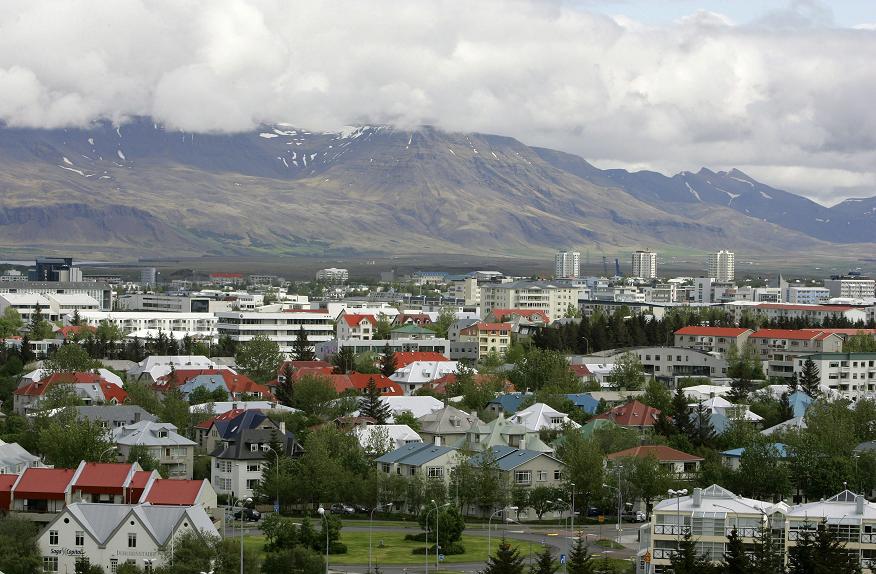Golfing in Iceland’s midnight sun: lava beds, angry birds, winds

REYKJAVIK – The names of the world’s greatest golf venues roll off the tongue like a putt rolling toward the cup. Pebble Beach. St. Andrews. Valderrama.
Then there are Vestmannaeyja and Porlakshafnar. Those names don’t trip off the tongues of anyone except the hardy residents of Iceland. Surprisingly, this island in the frigid North Atlantic is one of the most golf-obsessed places on earth.
With 65 courses for a population of 322,000, Iceland has more courses per person – one for every 5,000 people — than any other country.
Though many are just nine holes, that’s nearly twice as many courses per capita as Scotland, according to a 2007 survey by Golf Digest. The magazine said Scotland had the most courses per capita but it didn’t count countries with fewer than 500,000 people.
About 10 percent of Iceland’s population plays golf – a higher rate than the United States or Britain – making it the country’s second most popular sport, after soccer.
In contrast to America and Britain, golf club membership in Iceland is still growing, albeit more slowly than before the country’s banking bubble burst five years ago.
“We joke that if just three or four people are living near one another, they’ll probably start a golf club,” said Haukur Orn Birgisson, a young attorney who serves as vice chairman of the Icelandic Golf Union.
Indeed, some clubs have as few as 20 members, dedicated souls who will upkeep the course themselves.
Birgisson’s club, Golfklubberinn Oddur, just outside Reykjavik, is among the country’s largest, with 1,300 members. Like most clubs in Iceland it is open to the public as well as members, charging a guest fee of 6,900 Icelandic krona ($57).
Iceland’s golf season includes the annual Arctic Open tournament, scheduled this year for June 27 to 29. Open to amateurs and professionals alike, it’s played at the Akureyri Golf Club in northern Iceland, which boasts of being “the most northerly 18-hole golf course” on earth.
LAVA BEDS, TERNS, AND WINDS
Golf is popular in Iceland despite the obvious drawbacks. The season lasts just four months, from mid-May to mid-September. Summer temperatures rarely venture above 15 degrees Celsius (59 Fahrenheit) and even then occasional days of wicked winds and steady mist can keep all but the most foolhardy or dedicated off the course.
Call me both, because I played in exactly those conditions during a recent visit to Iceland. But I’ve played in even worse weather on past visits to Scotland.
Iceland does offer unique advantages and challenges to golfers. Most notably, in June, July and August, golfers can play virtually 24 hours a day.
Golfklubburinn Keiler in suburban Reykjavik is booked solid all summer with starting times from 8 a.m. until 10 p.m.. Playing under the midnight sun – as I discovered – can be surreal and sublime, with my first day starting time 10 p.m..
Another advantage: Iceland’s cool, moist climate makes for lush, green fairways. Also, golf courses don’t have trees to disrupt errant shots. Trees aren’t native in Iceland.
Iceland does, however, have lava beds, volcanic rock from past eruptions. They dominate the rough on many courses and are filled with crevices that can swallow golf balls like a whale gulping down krill.
The lava beds also are nesting sites for Arctic terns, birds that migrate from pole to pole. Golfers hitting near a tern’s nest will find themselves playing their next shot under aerial bombardment from the ill-tempered birds.
Formidable lava beds line the course on Heimaey Island, population 4,500, about three hours by car south east of Reykjavik. A lava flow from a 1973 volcanic eruption almost choked the harbor, but today cruise ships bring bird watchers, nature lovers and, yes, golfers.
The sheer cliffs, lava beds and sea vistas made it “the most dramatic course I have ever played”, said Kimber Bilby, an American from Michigan who played the course recently in calm weather with her fiancé, Bob Prust, a physician. One of their favourites was the par three 17th hole, which requires a tee shot across a sea inlet and lava beds to reach the green.
On the day the couple played, most golfers on the course were local Heimaey residents, many of them children of high-school and even grade-school age.
“I was watching the kids practice their chipping and putting, and they were awfully good,” said Prust. “It was obvious they had played the course many times.”
As for why golf is so popular here, Birgisson cites the Icelandic character.
“We always seem to go ‘all in,’ and golf is no exception,” he explained. “That mentality didn’t serve us well leading up to the banking crisis, but it has taken us far with golf.”



